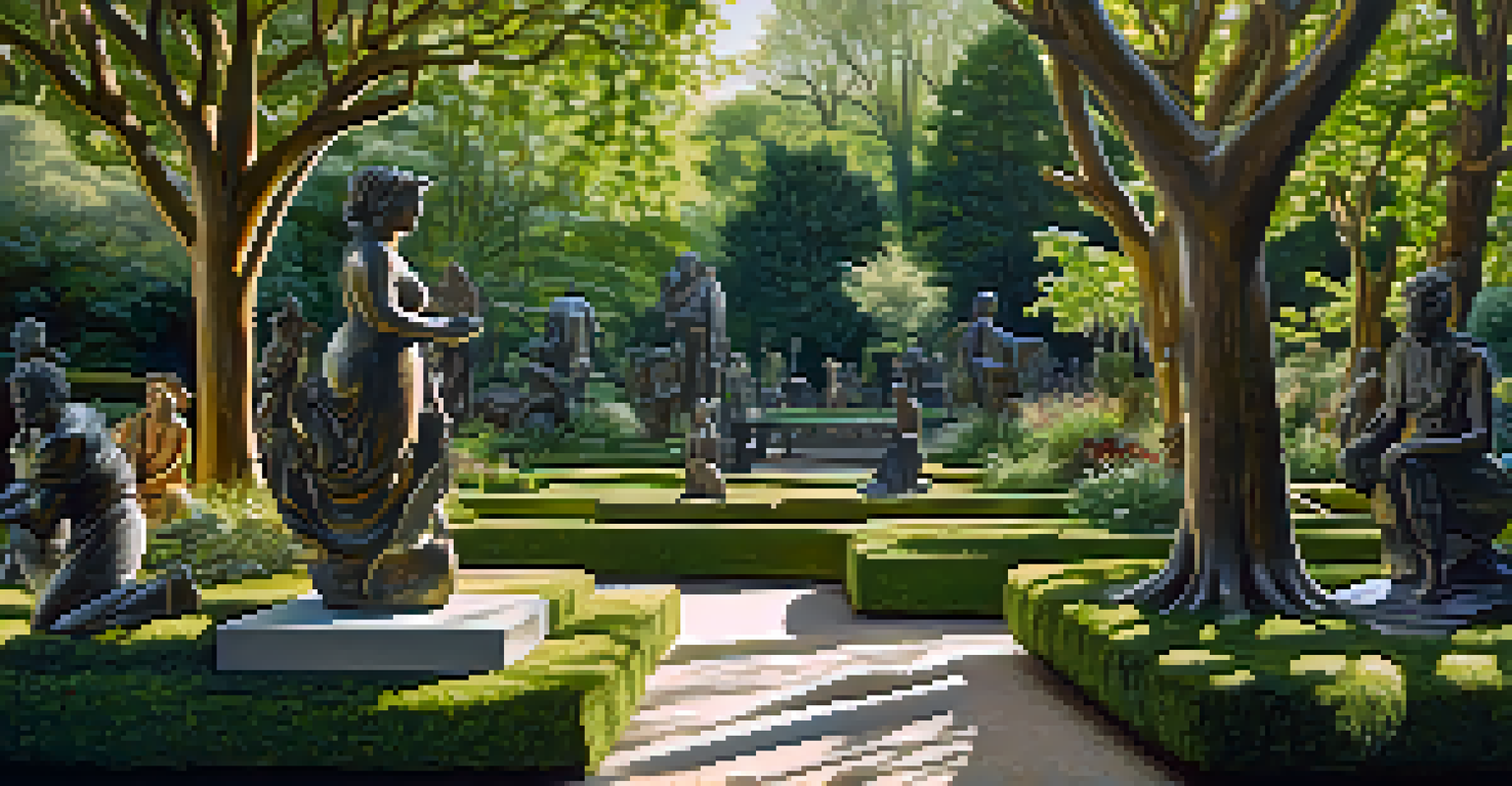The Power of Myths: How They Shape Artistic Identities

Understanding Myths and Their Significance in Art
Myths are more than just old stories; they encapsulate cultural values and truths that resonate across generations. They serve as a lens through which artists view the world, helping them express complex emotions, morals, and ideas. By tapping into these narratives, artists can create works that connect deeply with audiences, transcending time and place.
Myths are public dreams, dreams are private myths.
For instance, consider how the myth of Icarus, who flew too close to the sun, has inspired countless artists. This story reflects themes of ambition and hubris, making it relatable to anyone who has ever dared to dream big. When artists incorporate such myths into their work, they not only tell a story but also invite viewers to explore deeper meanings and personal connections.
Ultimately, myths act as a bridge between the past and present, allowing artists to explore their identities while connecting with universal themes. This interplay enriches the artistic landscape, ensuring that the relevance of these ancient tales continues to inspire new generations.
Cultural Myths and Their Impact on Artistic Expression
Cultural myths are the backbone of artistic expression, influencing both the themes and the mediums artists choose. They provide a rich tapestry of symbols, characters, and narratives that can be reinterpreted to reflect contemporary issues. For example, indigenous myths often highlight the relationship between humans and nature, a theme that resonates with today's environmental concerns.

Take the work of contemporary artists like El Anatsui, who draws from African myths to create stunning sculptures that speak to history and identity. By weaving these cultural narratives into their art, they not only honor their heritage but also challenge viewers to reconsider their own perceptions of culture and identity. This dialogue is crucial in a globalized world.
Myths Connect Cultures and Art
Myths serve as a lens for artists to express complex emotions and cultural values, creating connections that resonate across generations.
Moreover, these cultural myths allow artists to explore their roots while simultaneously addressing modern-day challenges. This blend of the old and the new fosters a dynamic art scene, where traditional stories are revitalized, encouraging a deeper understanding of diverse cultures and experiences.
Personal Myths: Crafting Individual Artistic Narratives
Beyond cultural myths, personal myths play a significant role in shaping an artist's identity. Each artist carries their own set of stories—experiences, dreams, and challenges—that inform their creative process. These personal narratives become the bedrock upon which unique artistic expressions are built, allowing artists to communicate their truth authentically.
Art is the most beautiful of all lies.
For instance, Frida Kahlo's art is deeply rooted in her personal experiences of pain and identity. Her self-portraits reflect her struggles and triumphs, creating a powerful narrative that resonates with many. Through her work, she has carved a space for exploring themes of gender, identity, and cultural heritage.
By embracing their personal myths, artists not only create compelling works but also invite audiences into their inner worlds. This vulnerability fosters a sense of connection, making the art more relatable and impactful. As artists share their stories, they empower others to explore their own narratives, contributing to a richer artistic dialogue.
The Role of Myth in Contemporary Art Movements
Contemporary art movements are often influenced by the resurgence of mythological themes, as artists seek to reclaim and reinterpret these narratives. From postmodernism to surrealism, myths serve as a wellspring of inspiration that fuels innovation and creativity. Artists use these themes to challenge societal norms and provoke thought, inviting viewers to question their beliefs.
For example, the feminist art movement has drawn heavily on mythological figures, reimagining them in ways that challenge traditional gender roles. Artists like Judy Chicago and Kiki Smith have utilized myth to explore female identity and empowerment, transforming ancient stories into modern commentaries. This approach not only honors the past but also paves the way for new interpretations.
Personal Narratives Shape Art
Artists' personal myths—rooted in their unique experiences—allow for authentic expressions that invite viewers into their inner worlds.
By integrating myth into contemporary art, artists create a dialogue that bridges the gap between history and modernity. This dynamic exchange enriches the art world, encouraging diverse perspectives and fostering an environment where creativity can flourish.
Myths as Tools for Social Commentary in Art
Myths often serve as powerful tools for social commentary, allowing artists to address pressing issues through allegorical storytelling. By embedding contemporary themes within mythic frameworks, artists can critique societal structures and provoke change. This method makes complex ideas more accessible and relatable to audiences.
Consider the work of artists like Ai Weiwei, who incorporates Chinese myths to comment on human rights and freedom of expression. His art challenges viewers to reflect on their own values and beliefs, urging them to engage in critical conversations. By using myths in this way, he transforms traditional narratives into catalysts for social awareness.
In this context, myths become more than stories; they evolve into vehicles for activism. As artists continue to explore these themes, they inspire audiences to reflect on their roles in society and the potential for change, fostering a sense of collective responsibility.
The Future of Myths in Artistic Identity
As we look to the future, the role of myths in shaping artistic identities remains as relevant as ever. Artists are increasingly turning to both ancient and modern myths to navigate the complexities of contemporary life. This synthesis of old and new allows for a rich exploration of identity that resonates with diverse audiences.
With the rise of digital art and global connectivity, the sharing and reinterpretation of myths have become more accessible. Artists are able to draw from a vast array of cultural narratives, creating a melting pot of influences that enrich their work. This cross-pollination fosters innovation and encourages a deeper understanding of shared human experiences.
Myths as Social Commentary Tools
By embedding contemporary themes in mythological frameworks, artists use myths to critique societal structures and inspire social change.
Ultimately, the power of myths lies in their ability to evolve and adapt. As artists continue to explore and reinterpret these narratives, they pave the way for future generations to find their own voices, ensuring that the legacy of myth remains a vital part of artistic identity.
Conclusion: Embracing Myths in Artistic Journeys
In conclusion, myths hold a profound power in shaping artistic identities, providing a rich source of inspiration that resonates across cultures and time. From personal narratives to cultural stories, they offer artists a canvas to explore complex ideas and emotions. By embracing these myths, artists not only honor their roots but also invite audiences into their unique journeys.
As we navigate an increasingly interconnected world, the importance of myths in art only grows. They serve as a reminder of our shared humanity and the stories that bind us together. Through their work, artists can spark conversations, challenge perceptions, and ultimately foster understanding among diverse communities.

So, whether you're an artist or an art lover, take a moment to reflect on the myths that shape your own identity. Engage with the stories being told, and consider how they influence your perspective on the world. After all, in the grand tapestry of human experience, we are all part of a larger narrative.